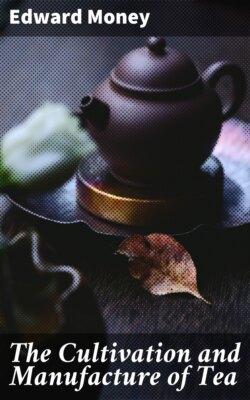Читать книгу The Cultivation and Manufacture of Tea - Edward Money - Страница 20
На сайте Литреса книга снята с продажи.
CHAPTER IV.
SOIL.
ОглавлениеTable of Contents
To pronounce as precisely on soil as to climate is not easy. The Tea plant will grow on almost any soil, and will flourish on many. Still there are broad general rules to be laid down in the selection of soils for Tea, which no one can ignore with impunity.
When first I turned my attention to Tea, I collected soils from many gardens, noting in each case how the plants flourished. I then sat down to examine them, never doubting to arrive at some broad practical conclusions. I was sadly disappointed. I found the most opposing soils nourished, apparently, equally good plants. I knew not then much about Tea, and judged of the Tea bushes mostly by the size (a very fallacious test); still, after-experience has convinced me I was more or less right in the conclusion I then came to, that several soils are good for Tea.
Nothing, then, but broad general rules can be laid down on this point, for I defy anyone to select any one soil as the best for Tea, to the exclusion of others.
A light sandy loam is perhaps as good a soil as any out of the Himalayas. It ought to be deep, and the more decayed vegetable matter there is lying on its surface the better. If deep enough for the descent of the tap-root, say 3 feet, it matters not much what the subsoil is, otherwise a yellowish red subsoil is an advantage. This subsoil is generally a mixture of clay and sand. Much of Assam, Cachar, and Chittagong is as the above, but, as a rule, it is richest in Assam, poorest in Chittagong.
Where the loam is of a greasy nature (very different to clay), with a mixture of sand in it, it is superior to the above, for it has more body. All good Tea soils must have a fair proportion of sand, and if not otherwise apparent, it may be detected by mixing a little of the soil with spittle and rubbing it on the hand. If the hand be then held up towards the sun, the particles of sand will be seen to glisten.
The soil so common in Kumaon, that is, light rich loam with any amount of decayed vegetable matter on it, and with a ferruginous reddish yellowish subsoil, is, I consider, the finest soil in the world for Tea. The rich decayed vegetable matter is the produce for centuries of oak leaves in the Himalayan forests, and, as all the world knows, oak only grows in temperate climes.
It was long believed that Tea would thrive best on poor soil. The idea was due to the description of Tea soils in China to be found in the first books that treated of Tea. But the fact that Tea, as a rule, is only grown in China on soil which is useless for anything else quite alters the case. If a soil is light and friable enough, it cannot be too rich for Tea.
Ball’s book “On the Cultivation and Manufacture of Tea in China” has much on Tea soils, but the opinions the author collected are sadly at variance, and on the whole teach nothing.
In conclusion, I will attempt to point out the qualities in soils in which the Tea plant delights, as also the qualities it abhors.
It loves soils friable, that is, easily divided into all their atoms. This argues a fair proportion of sand, but this should not be in excess, or the soil will be poor. The soil should be porous—imbibing and parting with water freely. The more decayed vegetable matter on its surface the better.
To be avoided are stiff soils of every kind, as also those which when they dry, after rain, cake together and split. Avoid also black-coloured, or even dark-coloured earths. All soils good for the Tea plant are light coloured. If, however, the dark colour arises from decayed vegetation, that is not the colour of the soil, and, as observed, vegetable matter is a great advantage. Judge of colour when soil is dry—for even light-coloured soil looks dark when wet. Soil which will make bricks will not grow Tea; and though I have sometimes seen young plants thrive on stiff soil, I do not believe in any stiff soil as a permanence.
Stones, if not in excess, are advantageous in all soils inclined to be stiff, for they help to keep them open. But then they must not be large, as if so they act as badly as a rocky substratum preventing the descent of the tap-root.
The reason, I take it, why Tea thrives best in light soils is that the spongioles or ends of the feeding roots are very tender, and do not easily penetrate any other.
There is more nourishment in stiffer soils, but for this reason the Tea plant cannot take advantage of it.
If a chosen soil be too stiff, it may be much improved for Tea by mixing sand with it. However, even where sand is procurable near, the expense of this is great. When done, the sand should be mixed with the soil taken out of the holes in which the plants are to be placed (see Transplanting), and it may be done again later by placing sand round the plants and digging it in. All this though is extra labour and very expensive, so none but a good Tea soil should ever be selected, and it is very easily found, for it exists in parts of all the districts discussed.
